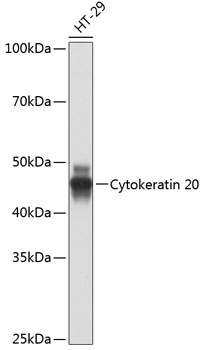Cell Death Antibodies 2
Anti-Cytokeratin 20 Antibody (CAB19041)
- SKU:
- CAB19041
- Product Type:
- Antibody
- Reactivity:
- Human
- Reactivity:
- Rat
- Host Species:
- Rabbit
- Isotype:
- IgG
- Research Area:
- Cell Death
Description
| Antibody Name: | Anti-Cytokeratin 20 Antibody |
| Antibody SKU: | CAB19041 |
| Antibody Size: | 20uL, 50uL, 100uL |
| Application: | WB IHC |
| Reactivity: | Human, Rat |
| Host Species: | Rabbit |
| Immunogen: | A synthesized peptide derived from human Cytokeratin 20 |
| Application: | WB IHC |
| Recommended Dilution: | WB 1:500 - 1:2000 IHC 1:50 - 1:200 |
| Reactivity: | Human, Rat |
| Positive Samples: | HT-29, Rat liver |
| Immunogen: | A synthesized peptide derived from human Cytokeratin 20 |
| Purification Method: | Affinity purification |
| Storage Buffer: | Store at -20°C. Avoid freeze / thaw cycles. Buffer: PBS with 0.02% sodium azide, 0.05% BSA, 50% glycerol, pH7.3. |
| Isotype: | IgG |
| Sequence: | Email for sequence |
| Gene ID: | 54474 |
| Uniprot: | P35900 |
| Cellular Location: | |
| Calculated MW: | 44kDa |
| Observed MW: | 44kDa |
| Synonyms: | CD20, CK-20, CK20, K20, KRT21, KRT20, Cytokeratin 20 |
| Background: | The protein encoded by this gene is a member of the keratin family. The keratins are intermediate filament proteins responsible for the structural integrity of epithelial cells and are subdivided into cytokeratins and hair keratins. The type I cytokeratins consist of acidic proteins which are arranged in pairs of heterotypic keratin chains. This cytokeratin is a major cellular protein of mature enterocytes and goblet cells and is specifically expressed in the gastric and intestinal mucosa. The type I cytokeratin genes are clustered in a region of chromosome 17q12-q21. [provided by RefSeq, Jul 2008] |
| UniProt Protein Function: | Function: Plays a significant role in maintaining keratin filament organization in intestinal epithelia. When phosphorylated, plays a role in the secretion of mucin in the small intestine |
| UniProt Protein Details: | By similarity. Ref.4 Ref.8 Subunit structure: Heterotetramer of two type I and two type II keratins. Associates with KRT8. Subcellular location: Cytoplasm Ref.6 Ref.7. Tissue specificity: Expressed predominantly in the intestinal epithelium. Expressed in luminal cells of colonic mucosa. Also expressed in the Merkel cells of keratinized oral mucosa; specifically at the tips of some rete ridges of the gingival mucosa, in the basal layer of the palatal mucosa and in the taste buds of lingual mucosa. Ref.6 Ref.7 Developmental stage: First detected at embryonic week 8 in individual 'converted' simple epithelial cells of the developing intestinal mucosa. In later fetal stages, synthesis extends over most goblet cells and a variable number of villus enterocytes. In the developing gastric and intestinal mucosa, expressed in all enterocytes and goblet cells as well as certain 'low-differentiated' columnar cells, whereas the neuroendocrine and Paneth cells are negative. Ref.1 Post-translational modification: Hyperphosphorylation at Ser-13 occurs during the early stages of apoptosis but becomes less prominent during the later stages. Phosphorylation at Ser-13 also increases in response to stress brought on by cell injury By similarity.Proteolytically cleaved by caspases during apoptosis. Cleavage occurs at Asp-228. Ref.4 Miscellaneous: There are two types of cytoskeletal and microfibrillar keratin: I (acidic; 40-55 kDa) and II (neutral to basic; 56-70 kDa). Sequence similarities: Belongs to the intermediate filament family. |
| NCBI Summary: | The protein encoded by this gene is a member of the keratin family. The keratins are intermediate filament proteins responsible for the structural integrity of epithelial cells and are subdivided into cytokeratins and hair keratins. The type I cytokeratins consist of acidic proteins which are arranged in pairs of heterotypic keratin chains. This cytokeratin is a major cellular protein of mature enterocytes and goblet cells and is specifically expressed in the gastric and intestinal mucosa. The type I cytokeratin genes are clustered in a region of chromosome 17q12-q21. [provided by RefSeq, Jul 2008] |
| UniProt Code: | P35900 |
| NCBI GenInfo Identifier: | 547750 |
| NCBI Gene ID: | 54474 |
| NCBI Accession: | P35900.1 |
| UniProt Secondary Accession: | P35900,B2R6W7, |
| UniProt Related Accession: | P35900 |
| Molecular Weight: | |
| NCBI Full Name: | Keratin, type I cytoskeletal 20 |
| NCBI Synonym Full Names: | keratin 20 |
| NCBI Official Symbol: | KRT20 |
| NCBI Official Synonym Symbols: | K20; CD20; CK20; CK-20; KRT21 |
| NCBI Protein Information: | keratin, type I cytoskeletal 20; keratin-20; protein IT; cytokeratin 20; cytokeratin-20 |
| UniProt Protein Name: | Keratin, type I cytoskeletal 20 |
| UniProt Synonym Protein Names: | Cytokeratin-20; CK-20; Keratin-20; K20; Protein IT |
| Protein Family: | Keratin |
| UniProt Gene Name: | KRT20 |
| UniProt Entry Name: | K1C20_HUMAN |







